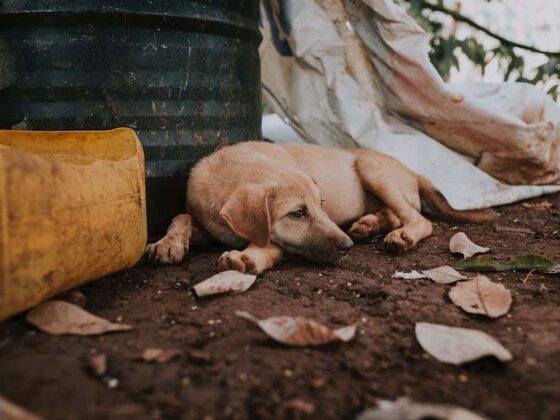The allure of colorful tulips gracing our gardens and homes is undeniable, but for dog owners, a question looms: Are tulips poisonous to dogs? This comprehensive guide seeks to shed light on the potential dangers these seemingly innocent flowers can pose to our furry companions. While tulips are celebrated for their beauty, they harbor chemical compounds that can be harmful to dogs when ingested. In this article, we will delve into the various facets of tulip toxicity, from understanding the toxic compounds to recognizing symptoms, risk factors, and the actions to take if your dog encounters these vibrant blooms. Stay informed to keep your beloved canine friends safe.
Are Tulips Poisonous To Dogs?
Yes, tulips are indeed poisonous to dogs. They contain alkaloids and glycosides that, when ingested, can lead to symptoms ranging from mild gastrointestinal upset to severe health issues like seizures and difficulty breathing. It’s essential for dog owners to be aware of the risks and take precautions to prevent their pets from accessing tulips or seek immediate veterinary care if ingestion is suspected.
Symptoms Of Tulip Poisoning In Dogs
The symptoms of tulip poisoning in dogs can vary in severity and may include:
- Drooling
- Vomiting
- Diarrhea
- Rapid heart rate
- Difficulty breathing
- Tremors or seizures
- Lethargy
- Loss of appetite
- Increased thirst
- Swelling and irritation of the mouth and throat
These symptoms may appear shortly after ingestion and can escalate rapidly. If you suspect your dog has ingested tulips, seek immediate veterinary assistance for proper diagnosis and treatment.
Factors Influencing Toxicity
Several factors can influence the toxicity of tulips in dogs:
Dog Breed Susceptibility: Some dog breeds may be more sensitive to tulip toxicity than others due to variations in their metabolism and tolerance to toxic compounds.
Quantity Ingested: The amount of tulip consumed plays a significant role. Larger quantities can result in more severe symptoms.
Part Of The Tulip Plant: Different parts of the tulip plant contain varying levels of toxins. Bulbs tend to be the most toxic, followed by leaves and stems.
Individual Sensitivities: Each dog may react differently to tulip toxins based on their size, age, overall health, and genetic predisposition. Understanding these factors is crucial in assessing the risk and potential toxicity level if a dog ingests tulips.
When Are Dogs Most At Risk?
Dogs are most at risk of tulip poisoning in the following situations and scenarios
Home Gardens: When dogs have access to gardens or flower beds where tulips are planted, especially if they dig up or chew on the tulip bulbs or other plant parts.
Bouquets And Flower Arrangements: If dogs can reach and nibble on tulips used in floral arrangements indoors or outdoors.
Seasonal Considerations: Dogs may be more at risk during the spring when tulips bloom and are more prevalent. To minimize the risk, dog owners should be vigilant during tulip blooming seasons and take precautions to keep their pets away from tulip plants and arrangements.
Treatment For Tulip Poisoning
Treatment for tulip poisoning in dogs typically involves the following steps and interventions:
Contact A Veterinarian: If you suspect tulip ingestion, seek immediate veterinary assistance. Provide the vet with details about the type of plant, the amount ingested, and the dog’s symptoms.
Inducing Vomiting: In some cases, a veterinarian may induce vomiting to remove any remaining tulip material from the dog’s stomach. This should only be done under professional guidance.
Activated Charcoal: Activated charcoal may be administered to absorb any toxins in the digestive tract and reduce their absorption into the bloodstream.
Intravenous (IV) Fluids: IV fluids help maintain hydration and flush toxins from the dog’s system.
Medications: Depending on the severity of symptoms, your veterinarian may prescribe medications to control vomiting, seizures, or other adverse effects.
Supportive Care: Provide supportive care, such as keeping the dog warm, comfortable, and monitored closely during recovery. The prognosis for tulip poisoning varies depending on the amount ingested and the promptness of treatment. Early intervention is crucial for a better chance of a full recovery.
Prevention And Dog Safety
Preventing tulip poisoning and ensuring dog safety around tulips involves several key measures:
- Education: Dog owners should be informed about the toxicity of tulips and other potentially harmful plants. Awareness is the first step in prevention.
- Garden Safety: If you have tulips in your garden, consider planting them in areas inaccessible to your dog. Use barriers like fencing or raised beds to keep dogs away from the plants.
- Alternative Plants: Choose dog-friendly plants for your garden, such as pet-safe flowers and herbs, to reduce the risk of accidental ingestion.
- Supervision: When your dog is outdoors, especially in areas with tulips, supervise their activities to prevent them from digging up or chewing on plants.
- Training: Training your dog to “leave it” or “drop it” can be invaluable in preventing plant ingestion.
- Flower Arrangements: Keep tulip arrangements out of reach of your dog. Place them on high surfaces or in rooms your dog cannot access.
- Safe Disposal: Dispose of any trimmed tulip parts or dead blooms securely, so your dog cannot access them in the trash.
By taking these precautions and being proactive, you can significantly reduce the risk of tulip poisoning and ensure the safety and well-being of your canine companion.
Conclusion
In conclusion, it’s vital for dog owners to be aware of the potential danger posed by tulips to their beloved pets. Tulips contain toxic compounds that can lead to severe health issues if ingested. Understanding the symptoms, risk factors, and immediate actions to take in case of suspected ingestion is crucial. Prevention, through education and responsible gardening, is key to keeping dogs safe from tulip poisoning. By prioritizing the well-being of our furry companions and staying informed, we can enjoy the beauty of tulips without compromising our dogs’ health.
FAQ’s
Can I Plant Tulips In My Garden If I Have A Dog?
Yes, but take precautions to ensure your dog cannot access the tulip bulbs or plants.
How Quickly Do Symptoms Of Tulip Poisoning Appear In Dogs?
Symptoms may appear within hours of ingestion, so prompt action is crucial.
Can Tulip Toxicity In Dogs Be Treated At Home?
No, always seek immediate veterinary care for suspected tulip poisoning.
Are All Parts Of The Tulip Plant Equally Toxic To Dogs?
No, the bulbs are the most toxic, followed by leaves and stems.
Are There Dog-Friendly Alternatives To Tulips For Gardens?
Yes, consider planting pet-safe flowers like marigolds or herbs like lavender.










